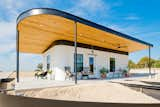At 500 square feet, ICON’s stylish new structure was 3D-printed over the course of several days—but it only took 27 hours of labor to construct. The building will serve as a welcome center at Austin’s new Community First! Village—a 51-acre development that will provide affordable housing to men and women coming out of chronic homelessness. Six new 3D-printed homes will be added to the village by the end of this year—and ICON says that they can be built at significantly less cost than conventional homes.
Drawing inspiration from minimalist design, Sabine is a sophisticated, modern sofa. A deep, biscuit-tufted, attached bench cushion invites the whole family to lounge. The stainless steel base and tall legs add an elegant contrast. #madeinamerica #furniture #living
The David and Lucile Packard Foundation Headquarters (Los Altos, California: 2012)
The forward-thinking headquarters of the David and Lucile Packard Foundation, created in 2012, embodies the vision and mission of the philanthropic concern, a reflection of the Hewlett-Packard founder’s passion for the environment and technology. An angular grid of configurable office suites encircling an open courtyard, the Bay Area site reflects the region, sporting salvaged wood, local stone, and a red cedar exterior. And while the structure itself, a Net Zero Energy Building that earns LEED Platinum certification, is impressive, the architects at EHDD did one better by shaping culture as well as space. An energy audit revealed that the staff’s emissions were generated mostly from transportation, so EHDD added video conferencing suites and a shuttle to pick up staff from the nearby rail station.
Photo by Jeremy Bitterman
For the Knoxville-based CEO of environmentally-focused marketing firm the Shelton Group, building an off-the-grid lakefront pavilion in Sharps Chapel, Tennessee, wasn’t so simple. With the help of architect Brandon Pace, she built a small prefabricated cabin on a “funky piece of property” on Norris Lake, a man-made reservoir.






